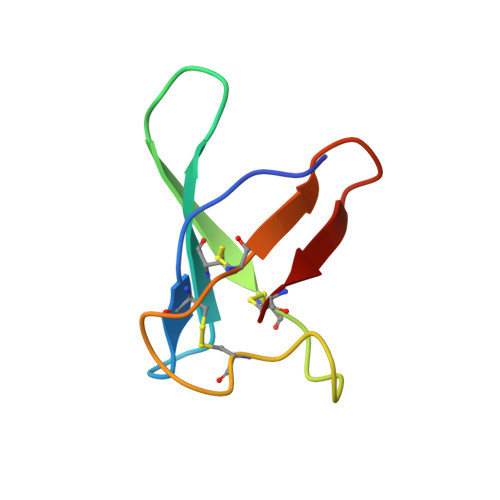DMSO-Induced Unfolding of the Antifungal Disulfide Protein PAF and Its Inactive Variant: A Combined NMR and DSC Study.
Czajlik, A., Batta, A., Kerner, K., Fizil, A., Hajdu, D., Raics, M., Kover, K.E., Batta, G.(2023) Int J Mol Sci 24
- PubMed: 36674720
- DOI: https://doi.org/10.3390/ijms24021208
- Primary Citation of Related Structures:
7NXI, 7PGD - PubMed Abstract:
PAF and related antifungal proteins are promising antimicrobial agents. They have highly stable folds around room temperature due to the presence of 3-4 disulfide bonds. However, unfolded states persist and contribute to the thermal equilibrium in aqueous solution, and low-populated states might influence their biological impact. To explore such equilibria during dimethyl sulfoxide (DMSO)-induced chemical unfolding, we studied PAF and its inactive variant PAF D19S using nuclear magnetic resonance (NMR) and differential scanning calorimetry (DSC). According to the NMR monitoring at 310 K, the folded structures disappear above 80 v / v % DMSO concentration, while the unfolding is completely reversible. Evaluation of a few resolved peaks from viscosity-compensated 15 N- 1 H HSQC spectra of PAF yielded ∆G = 23 ± 7 kJ/M as the average value for NMR unfolding enthalpy. The NMR-based structures of PAF and the mutant in 50 v / v % DMSO/H 2 O mixtures were more similar in the mixed solvents then they were in water. The 15 N NMR relaxation dynamics in the same mixtures verified the rigid backbones of the NMR-visible fractions of the proteins; still, enhanced dynamics around the termini and some loops were observed. DSC monitoring of the T m melting point showed parabolic dependence on the DMSO molar fraction and suggested that PAF is more stable than the inactive PAF D19S . The DSC experiments were irreversible due to the applied broad temperature range, but still suggestive of the endothermic unfolding of PAF.
Organizational Affiliation:
Department of Organic Chemistry, Faculty of Science and Technology, University of Debrecen, Egyetem tér 1, H-4032 Debrecen, Hungary.














